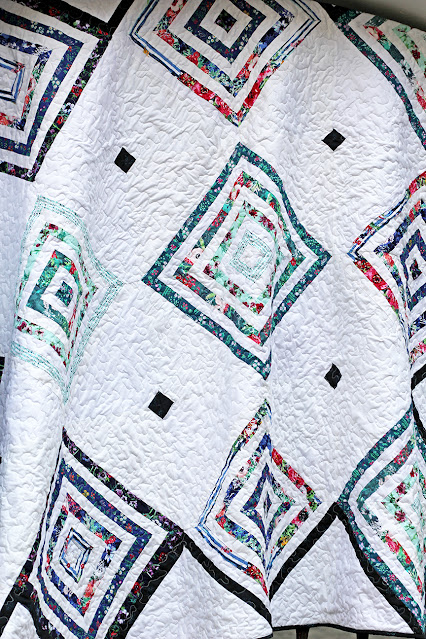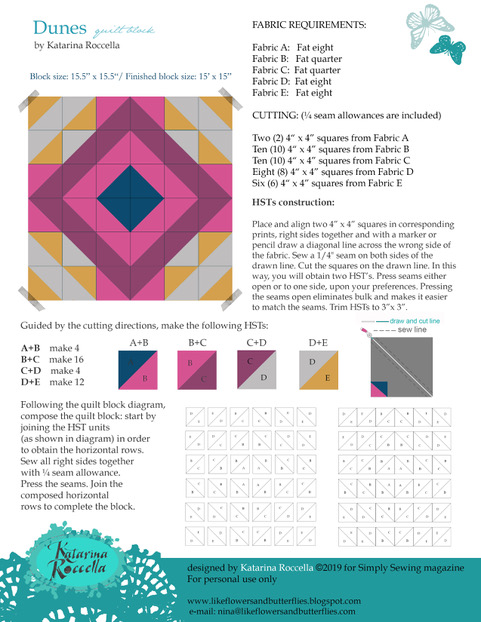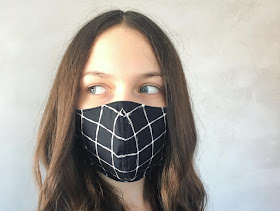Last year, I was asked to create something simple and fun for the Simple sewing magazine, featuring my color master designer box collection. So I designed this easy block constructed with 3" HSTs and turned it into a pillow, actually I made two;)
I was brainstorming ideas for the pillows for my just released Picturesque collection and as HTS are always a good idea for the pillow covers, I used the same block! I also got some HST left overs, so I created another composition, but I will show them both in my next blog post, just wanted to have the original version saved here, before ;)
So here it goes:
Decorative pillow covers are the easiest and fastest way to change the home décor, without major investment. Bold and funky patterns can sometimes be too much or too busy if used in bigger home décor projects, but can be awesome if used for smaller scales projects, like pillows, to embellish and add a touch of color and pattern in your home space. Additionally, quilting adds a bit of texture and stabilize the sewing/piecing, while trimming around the edges, adds a modern look.
To get the printable template, download it HERE
The featured fabrics: “Paprounes Crimson”, “Uninhibited Fashion”, “Steps Above Prism”, “Greeka Fouxia” and “Morse Dot Sun” from the “Designer’s palette, edition #1” by Katarina Roccella for Art Gallery Fabrics.
Materials
For 1 pillow, finished size 15 x 15”
-Fabrics:
Fabric A: Paprounes Crimson, Fat eight
Fabric B: Uninhibited Fashion, Fat quarter
Fabric C: Steps Above Prism, 5/8 yard
Fabric D: Greeka Fouxia, Fat eight
Fabric E: Morse Dot Sun, Fat eight
Decorative trim (pom-pom or similar): 2 yds
-Medium weight, one-sided fusible interfacing or batting - 16 x 16” piece
-Pompom or other decoratiove trim, 65” long (2 yds)
-16x16” or 15x15” pillow insert
-Cutting mat and rotary cuter* optional
-Ruler
-Scissors
-Iron
-Needle and thread
-Sewing machine
-Pins
-Fabric pencil or marker
CUTTING:
¼ seam allowances are included
Two (2) 4“ x 4” squares from Fabric A
Ten (10) 4“ x 4” squares from Fabric B
Two (2) 17“ x 22” rectangles from Fabric B (for pillow back)
Ten (10) 4“ x 4” squares from Fabric C
Eight (8) 4“ x 4” squares from Fabric D
Six (6) 4“ x 4” squares from Fabric E
Pillow front
To make the pillow front, there are total of 36 HSTs (half-square triangles).
Guided by the cutting and fabric requirements, make the following HSTs:
A+B make 4
B+C make 16
E+D make 12
D+C make 4
HSTs construction:
Place and align two 4” x 4” squares in corresponding prints, right sides together and with a marker or pencil draw a diagonal line across the wrong side of the fabric. Sew a 1/4" seam on both sides of the drawn line. Cut the squares on the drawn line. In this way, you will obtain two HST’s. Press seams either open or to one side, upon your preferences. Pressing the seams open eliminates bulk and makes it easier to match the seams. Trim HSTs to 3 x 3”.
Following the quilt block diagram, compose the quilt block: start by joining the HST units (as shown in diagram) in order to obtain the horizontal rows. Sew all right sides together with ¼ seam allowance. Press the seams. Join the composed horizontal rows to complete the block. Press the seams. Fuse the interfacing on the wrong side of the block /pillow front or pin the piece of batting and quilt it. If needed, trim and square the pillow front.
Adding the trim
With right side of the pillow front up, start pinning the trim all way around, starting from one corner and rounding it slightly on all corners. Sew the trimming in place, with the smallest seam allowance possible, finishing where you started, overlapping the trim’s edges.
Note: there are different weights, qualities and sizes of the trims, and depending on that, you may be able or not to slightly round the corners for the nice and professional finish. Thinner and softer trimmings are more suitable for shaping, while with thicker trimmings, you may be forced to cut the trimming separately for each of the pillow’s edges and overlap the edges on all corners.
Pillow back
The easiest way to make the pillow back is with simple envelope back.
Take the rectangles cut for the pillow back, fold and press them on the longer side (22”) in half, wrong sides inside, so that you obtain two 17 x 11” pieces.
Pillow assemble
Overlap the back pieces, squaring them and place the pillow front with right side inside-facing the overlapped backs. Pin all layers together and cut the backs leftover edges to the size of the pillow front- 15.5 x 15.5”. Sew around all edges with ¼ seam allowance, rounding the corners slightly, to prevent protruding. Turn the pillow case right side out and place the pillow insert inside.
xx
Katarina















































